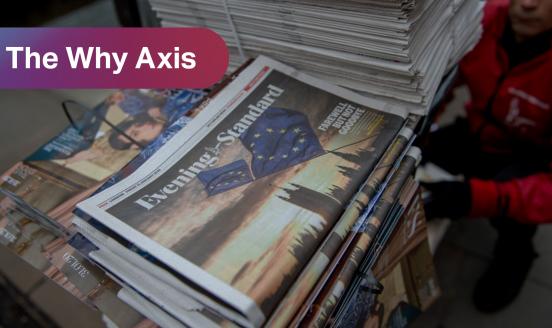Fact: Banco Espirito Santo gets a 4 billion euro recap
Over the weekend, Portuguese authorities announced the recapitalisation plan for Banco Espirito Santo, involving a 4.4 bn euro capital injection. BES
Over the weekend, Portuguese authorities announced the recapitalisation plan for Banco Espirito Santo, involving a 4.4 bn euro capital injection. The plan will also include a bail-in of junior debtholders and shareholders as well as a restructuring of the bank, which will be split in two. BES is a test case for the new European approach to the management of banking crises and will be an important case study for policy makers.
After a month of rumors and suspicion, the extent of Banco Espirito Santo’s troubles - once Portugal’s biggest lender - have fully come into light. The central bank of Portugal unveiled on 3rd August a recapitalisation plan, including a restructuring of the bank and bail-in of shareholders and junior debt-holders.
This comes after the bank announced 3.6bn euro losses on July 30, greatly exceeding what was anticipated from previously published information.
As a consequence, BES fell below the minimum solvency ratios in force (recording a Common Equity Tier 1 ratio of 5 per cent, i.e. 3 percentage points below the minimum regulatory level) and its access to the ECB’s liquidity was suspended.
According to the Central bank, “the public perception of the Banco Espírito Santo, S.A. deteriorated further, as shown by the strongly negative performance of its securities, undermining depositors’ confidence. This negative public perception led to the suspension of transactions on Friday afternoon, 1 August 2014, with the risk of contaminating the perception regarding the other institutions of the Portuguese banking system”. In other words, thanks god it was friday, or the week could possibly have ended with a deposit run.
Source: WSJ
BES will end up being restructured and split in two units. A new “good bank” or bridge bank in the European Commission’s wording, will collect depositors, senior bondholders and healthy assets, whereas bad loans, shareholders’ fund and junior creditors will remain in the old unit that will eventually be shut down. The new EU state aid regime, which was set in place by the European Commission last summer in order to deal with the transition towards the full Bank Recovery and Resolution Directive’s (tougher) provision, requires in fact the imposition of losses on shareholders and junior bondholders before using public funds. Senior debt will instead not be touched. Whether or not the bail-in of junior debt will be enough to absorb losses cannot be certain, especially in light of uncertainty prevailing on the actual size of intra group operations and final exposures. This will be an important variable to look at, with potential effects on the final outcome for public finances.
The newly created “good bank” will be capitalised by the Portuguese Resolution Fund, which will underwrite all its equity, to the amount of 4.9bn. Since the Portuguese Resolution Fund does not actually have enough money to do that - it’s been created in 2012 - it will receive a loan of 4.4 bn euro by the Portuguese State. And the Portuguese State allegedly will draw on some 6.4bn euro leftovers from the IMF/EU bailout funds that were specifically earmarked to banks’ assistance.
Whether or not the operation will turn out to be neutral, for public finances, will depend on whether and how this loan will be reimbursed. This is a very important point in light of Europe’s struggle to overcome the sovereign-banking fragilities that has emerged as a characteristic feature of the crisis and meet the objective that taxpayers’ money are less on the frontline in the future. But there seems to be a bit of confusion on this crucial point, at the moment,
The European Commission states that this loan will be primarily reimbursed by the proceeds of the sale of assets of the Bridge Bank. Which means that the ultimate outcome for the Portuguese State is uncertain, and it will ultimately depend on the valuation that will be given to these assets, on the interest of investors in them and on the actual value that it will be possible to extract on the market. Incidentally, the central Bank of Portugal does not mention asset sales for the bridge bank but suggests that “the loan granted by the State to the Resolution Fund will be temporary and replaceable by loans granted by credit institutions”. On top of this, there is the issue of whether the bad bank will be able to function up to the point when it will be wound up without any additional funding.
A second point raised by this case concerns the supervision of very complex cross border structures (like BES turned out to be). It is by now known that the problems of BES stem from the very opaque transactions that were conducted within its highly complex group structure. As a reminder, Figure 1 shows the ownership chain. BES is 25% owned by ESFG (Espirito Santo Financial Group). 49% of ESFG is owned by Espirito Santo Irmaos SGPS SA, which in turn is fully owned by Rioforte Investment, which is in turn fully owned by ESI (Espirito Santo International).
Source: Tracy Alloway FT (@tracyalloway)
Frances Coppola has a must read detailed account of how the intra-group exposure led to the disastrous results. In short, BES was exposed to Rioforte for 270mn euro. It’s exposure to EFSG and subsidiaries in Panama and Luxembourg accounts for 927mn (most usecured) and it is interesting to point out that BES had sold debt issued by ESI and Rioforte to its own retail customers through its branches, with a guarantee to be provided by ESFG. When EFSG filed for creditor protection in Luxembourg, BES was also left to bear the guarantee to its retail clients that ESFG was no longer able to provide. 297mn euro more problems for BES came from the sell of ESCOM by Rioforte to an Angola company, which apparently never paid back. BES's actual exposure to debt securities from other parts of its Group that it has sold through its branches to clients is not yet clear but it could reach up to 3bn euro. And this may not even be the full story, as it seems that in July the existence of three special purpose entities (SPEs) was found out, whose assets mainly consisted of bonds issued by BES and that were kept off the book.
Source: BES results
This picture shows probably better than anything else why the establishment of a single supervisor is an absolute necessity in Europe. Part of the reason why all this could happen even though - it is important to stress it once again - Portugal was under an EU/IMF/ECB programme that included also a monitoring of the financial sector, is that the complexity of this group was out of reach for the national supervisory authority that was in charge (Rioforte and ESI for example are based in Luxembourg, and they are not banks).
A third question concerns the bank-bank cross holdings. Figure 1 shows that the second largest shareholder of BES is in fact another bank, i.e. Credit Agricole. Credit Agricole said on Tuesday that it took a 708 mn euro hit from its stake in BES, nearly wiping out its second-quarter net profit, which fell 97.5 percent to 17 million euros. This raises a point of general importance, as banks tend to be important investors into other banks, also outside the Portuguese case. Almost 40% of securities other than shares issued by banks in the euro area are held by other banks in the euro area at the aggregate level, according to ECB data. The next question to ask therefore could be whether by trying to solve the sovereign-bank vicious circle we are not just unveiling another one, that deserve equal attention.



